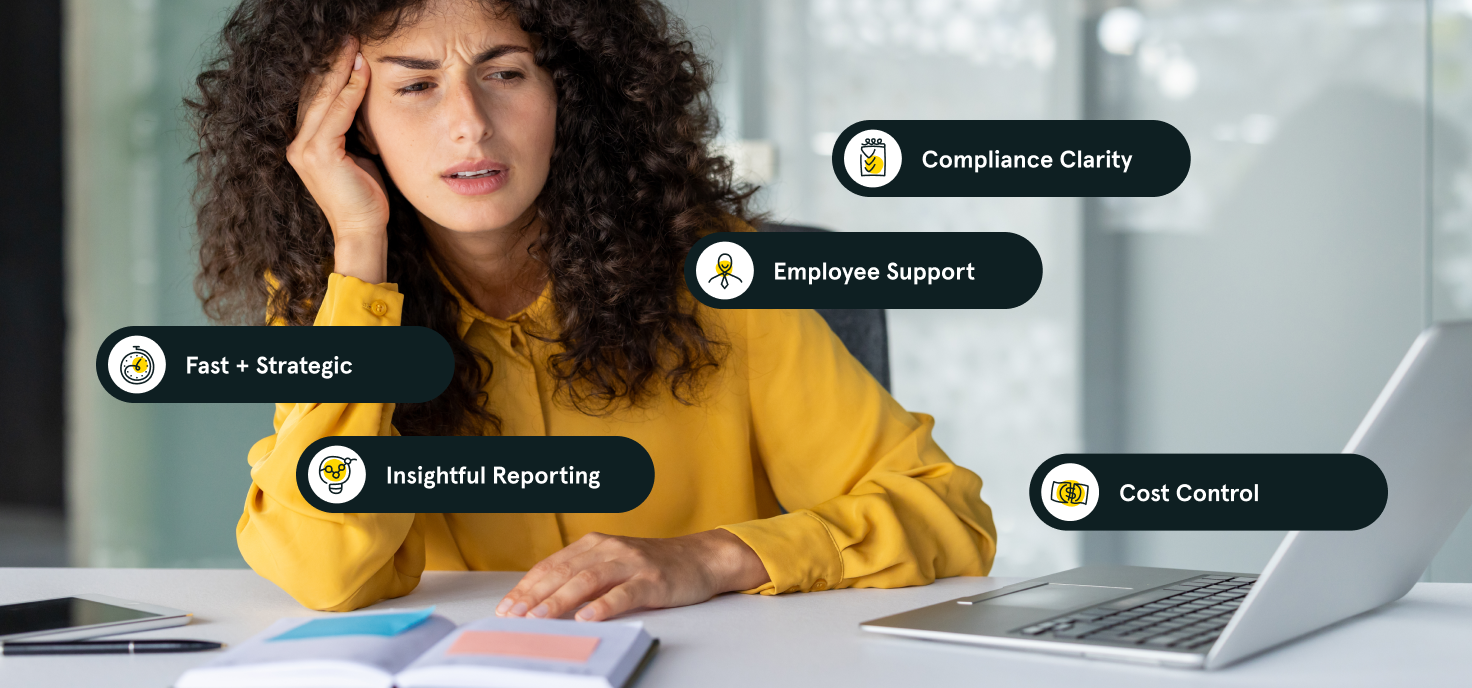Not all vendors are built to handle what HR teams actually face.
Leave and benefits administration isn’t just paperwork. It’s a balancing act between compliance and care, between budget and employee satisfaction, between urgent needs and long-term strategy. When your partner isn’t built to manage that balancing act, the cracks start to show.
When picking a leave management partner, larger companies tend to gravitate towards a couple of different models:
- Big generalist providers offer standardized, low-touch solutions focused on high-volume processing at a lower cost.
- High-touch, tech-backed providers take a more strategic and integrated approach, working closely with your team to tailor solutions, provide personalized guidance, and drive long-term program improvements.
But which of these providers are better equipped to solve the real challenges that keep your HR team up at night? In this article, we’ll dig into five common problems HR teams face, and look at how each model approaches them.

1. Compliance clarity in a moving landscape
The problem:
State laws shift. Federal guidance evolves. Employees work across multiple jurisdictions. Staying compliant takes time and legal fluency, most internal teams just don’t have.
What’s the generalist’s approach?
Generalist providers tend to standardize their processes for efficiency, applying a broad framework across all clients. While this can work for basic programs or single-state workforces, it often misses the nuance required for multi-state compliance or more complex policies. Regulatory updates may be shared passively—through portal updates or quarterly newsletters—and support is typically reactive rather than proactive.
What’s the high-touch approach?
High-touch, tech-backed providers take a more hands-on role in compliance. Legal and compliance specialists stay on top of legislative changes across the U.S. and Canada, offering tailored updates to clients based on their specific footprint. Partners like Larkin provide clients access to on-demand compliance resources, ongoing training webinars, and one-on-one guidance that not only keep HR teams informed but also help them feel confident and prepared.
Who’s got the upper hand?
Generalists may provide basic compliance alerts or centralized documentation that meets the minimum threshold. But for organizations navigating multiple jurisdictions or managing more complex policies, the high-touch model offers significantly more value. It pairs up-to-date expertise with responsive, practical support—and ensures HR teams aren’t left interpreting legal changes alone.
 How do I know if my partner is taking the right approach?
How do I know if my partner is taking the right approach?
If your partner isn’t proactively surfacing policy changes or offering recommendations before you ask—they’re not a partner, they’re a processor.
2. Supporting employees without overloading HR
The problem:
When an employee needs to take a leave of absence, it’s often during a personal or stressful moment. The way that process is handled—how clear the communication is, how empathetic the tone, how responsive the support—can significantly impact how employees feel about their workplace. But delivering that kind of personalized support on every case can be nearly impossible for internal HR teams who are already stretched thin.
What’s the generalist’s approach?
Generalist providers typically manage employee interactions through centralized service teams and standard communication templates. While this can work for straightforward claims, it often lacks continuity or a sense of personal connection. Employees may speak to different representatives each time they call, and the experience can feel transactional—especially during sensitive or urgent situations.
What’s the high-touch approach?
High-touch, tech-backed providers take a more relationship-based approach to employee support. Instead of a rotating call center model, they assign a dedicated admin who serves as a consistent point of contact for employees throughout the entire leave process. Partners like Larkin also prioritize empathy and clarity in communications, and give employees access to direct support from real people as well as useful tools like a mobile portal, so they feel guided, not left guessing.
Who’s got the upper hand?
Generalists may provide efficient case handling for high volumes, but that efficiency often comes at the cost of employee experience. For organizations where culture, retention, and employee well-being are priorities, high-touch providers offer a deeper level of care and continuity that’s hard to replicate at scale.
 How do I know if my partner is taking the right approach?
How do I know if my partner is taking the right approach?
If employees regularly escalate questions back to your HR team or complain about inconsistent communication, your partner may be missing the mark on employee experience.

3. Balancing fast fixes with long-term strategy
The problem:
Managing a leave program often involves two different needs at once: resolving today’s issues and shaping tomorrow’s policies. HR teams may need immediate help handling complex claims while also navigating broader questions around leave design, workforce trends, or upcoming organizational changes. The challenge is finding a partner who can do both.
What’s the generalist’s approach?
Generalist providers are typically structured to handle transactions at scale. Their core focus is on processing claims accurately and consistently, which makes them effective at the operational layer. But they rarely step into a strategic role. Recommendations on program design, benchmarking, or policy innovation may be limited—or not offered at all.
What’s the high-touch approach?
High-touch, tech-backed providers are often more embedded in their clients’ day-to-day and long-term planning. They’re designed to solve immediate issues while also offering insight into how the program could evolve. Partners like Larkin assign dedicated client services managers who stay connected to your goals and can help you adjust policies, optimize workflows, or prepare for growth. That ongoing relationship allows for more nuanced, forward-thinking support.
Who’s got the upper hand?
For basic claims processing, generalists can be reliable. But when your leave program needs to adapt, scale, or improve, a high-touch partner is better positioned to offer both the day-to-day support and the strategic guidance to make it happen.
 How do I know if my partner is taking the right approach?
How do I know if my partner is taking the right approach?
If your provider hasn’t made a single recommendation in the past six months—or you
4. Reporting that actually informs decisions
The problem:
HR leaders need more than raw numbers. Whether it’s for executive presentations, vendor performance reviews, or identifying internal trends, data should help teams understand what’s working and what’s not—and point to next steps. But too often, reporting is delivered without context or clear takeaways.
What’s the generalist’s approach?
Generalist providers are typically structured to handle transactions at scale. Their core focus is on processing claims accurately and consistently, which makes them effective at the operational layer. But they rarely step into a strategic role. Recommendations on program design, benchmarking, or policy innovation may be limited—or not offered at all.
What’s the high-touch approach?
High-touch, tech-backed providers take a more collaborative approach to reporting. They tailor outputs to what matters most to the client and deliver context alongside the data. Partners like Larkin combine data with trend analysis, surface patterns, and offer guidance on how to act on what the numbers are saying. When needed, they also help shape reporting for different stakeholders—whether it’s a broker, executive team, or compliance lead.
Who’s got the upper hand?
Generalists can supply the numbers—but high-touch providers help teams understand what they mean. For HR leaders who need to drive decisions or justify investments, that layer of analysis can make all the difference.
 How do I know if my partner is taking the right approach?
How do I know if my partner is taking the right approach?
If every report looks the same quarter after quarter—or if you’re always the one asking the questions—it may be time for a partner who brings more to the table.
5. Avoiding surprise costs and operational lock-in
The problem:
Leave administration isn’t static. Whether due to new business units, policy changes, or compliance shifts, most organizations will need to adapt their programs over time. When vendors aren’t flexible—or start charging for every adjustment—costs and frustration can escalate quickly.
What’s the generalist’s approach?
Generalist providers are typically structured to handle transactions at scale. Their core focus is on processing claims accurately and consistently, which makes them effective at the operational layer. But they rarely step into a strategic role. Recommendations on program design, benchmarking, or policy innovation may be limited—or not offered at all.
What’s the high-touch approach?
High-touch, tech-backed providers tend to be more transparent and collaborative in how they structure pricing and support. Partners like Larkin work with clients and brokers to align pricing with actual needs and avoid nickel-and-diming for basic services. And because they’re not tied to bundled insurance packages, they offer more flexibility if your organization wants to shift vendors or adjust benefit offerings.
Who’s got the upper hand?
Generalists may offer a lower price tag on paper—but that value often erodes over time due to hidden costs or limited adaptability. High-touch providers offer more predictability and freedom to grow without being locked into an inflexible structure.
 How do I know if my partner is taking the right approach?
How do I know if my partner is taking the right approach?
If pricing surprises keep showing up—or you’re told a system update is “out of scope”—it’s worth asking whether your current partner is set up to grow with you.
Not all leave administration partners are built for the real-world challenges that HR teams face every day. Generalist providers can be effective for straightforward programs—but for organizations managing complexity, growth, or elevated employee expectations, that model often falls short.
High-touch, tech-backed providers are designed to do more than process claims. They deliver guidance, provide continuity, and take work off your plate—so your team can focus on the bigger picture. If you’d like to hear more about what a high-touch tech-backed approach could help you achieve, we’d love to chat with you.



